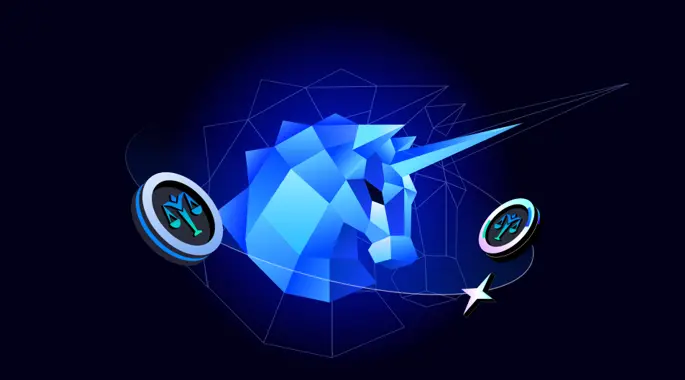LK Venture Research Report: Can Kaspa Become the POW New Star that Solves the Impossible Triangle?
Author: LK Venture
TL; DR
Kaspa adopts the GHOSTDAG protocol, significantly enhancing network performance while ensuring network security. Launched in November 2021, it has considerable innovations compared to similar DAG projects and theoretically supports smart contract development.
The core developers possess strong technical capabilities, with published papers cited in the Ethereum white paper, continuously expanding and improving the theory over the years.
The project is 100% community-driven, with no investment institutions involved; all tokens are produced through POW mining. Currently listed only on second and third-tier exchanges, it has a circulating market cap of $530 million and an FDV of $850 million, with potential for listing on Binance in the future.
In a risk-neutral scenario, the FDV is expected to reach $1.5-4 billion within two years, providing a growth potential of 1-4 times.
Technical development progress has not met expectations, with delays or failures in smart contracts and stagnation in ecosystem development.
Project Details
Kaspa is a POW public chain built on the GHOSTDAG protocol, aiming to solve the blockchain trilemma. The GHOSTDAG protocol is a generalization of Bitcoin consensus, and since it has no additional assumptions, it is theoretically as secure as Bitcoin. Unlike Bitcoin, GHOSTDAG does not use a single chain structure but rather an interwoven directed acyclic graph (DAG) structure, where one block can point to multiple blocks. In simple terms, while ensuring security, Kaspa features fast transaction speeds, high throughput, and decentralization.
The Kaspa mainnet launched in November 2021, with a total token supply of 28.7 billion KAS, and a current circulating supply of approximately 17.7 billion KAS, with a market cap of $530 million.

Kaspa circulating market cap changes, source: CoinMarketCap
Kaspa Technical Features
Fast Transaction Speed, High Throughput
Bitcoin has a slow block generation speed, which means that transactions take a long time to be confirmed. Currently, Bitcoin generates one block every 10 minutes, with each block accommodating about 4,000 transactions, resulting in a TPS of about 7, which is far from sufficient for high-concurrency applications. Kaspa eliminates security as a bottleneck for high throughput through GHOSTDAG and optimizes bandwidth costs and network infrastructure for high throughput. Specifically, Kaspa can currently generate one block per second, with each block accommodating 300 transactions, achieving a TPS of 300, which is over 40 times that of Bitcoin. Kaspa aims to generate 10 blocks per second, or even 100 blocks, indicating significant room for improvement compared to current performance.
Decentralized Mining
For individual miners, mining Bitcoin solely based on their own computing power is very challenging, making it a better choice to join large mining pools to obtain corresponding rewards. Benefiting from economies of scale, consensus power is concentrated in a few large mining pools. Currently, the top three Bitcoin mining pools account for 66% of the total hash rate. In contrast, Kaspa's high block generation speed reduces the difficulty for small miners, helping to achieve decentralization in mining, with the top three mining pools accounting for only 26% of the total hash rate.

BTC mining pool hash rate distribution, source: Mining Pool Stats
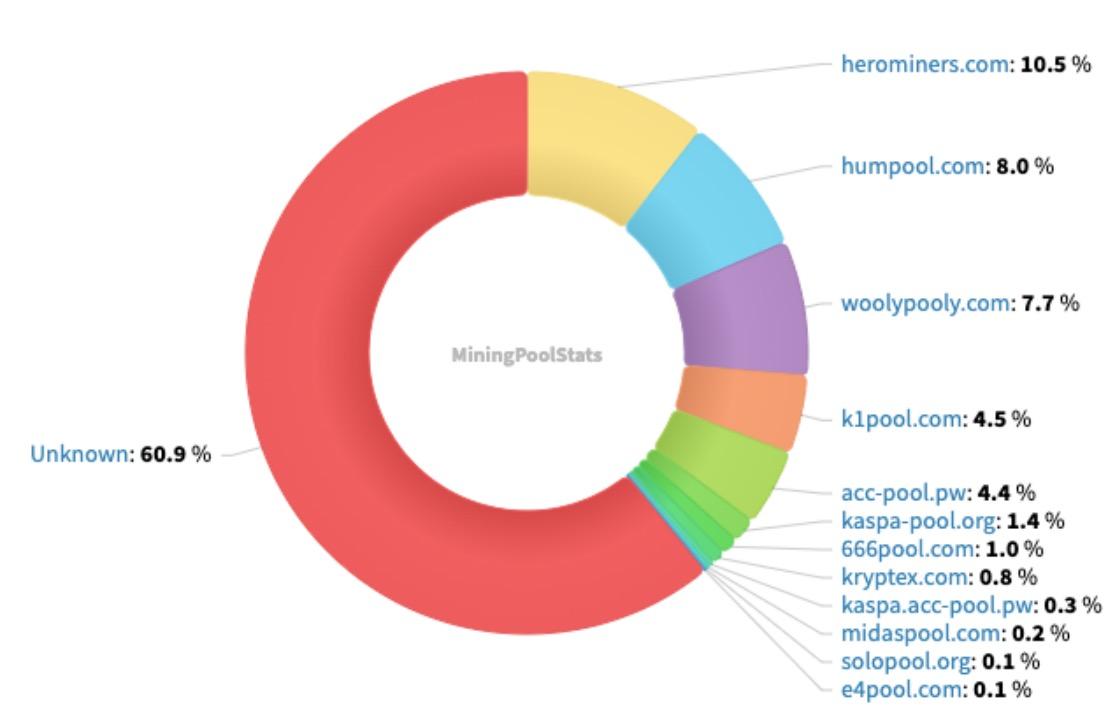
Kaspa mining pool hash rate distribution, source: Mining Pool Stats
Scaling Principle: From PHANTOM to GHOSTDAG
The difficulty of scaling Bitcoin lies in the fact that directly reducing block generation time or increasing block size can cause broadcasting speed to lag behind block generation speed, leading to blockchain forks, which reduces overall network security. Even under normal circumstances, forks may occur due to network latency and other reasons. Bitcoin uses "longest chain consensus" to select one valid main chain to ensure network security, which also reduces network efficiency.
Scaling Choice: DAG Network
DAG is a network structure that allows for forks, where multiple blocks can be generated simultaneously, and one block can point to multiple blocks, meaning that block generation speed and throughput can be rapidly increased. Therefore, the DAG structure is inherently suitable for enhancing TPS. However, allowing blocks to be generated in parallel inevitably leads to transaction conflicts, known as the "double-spending" problem. Determining the order of transactions is key to the success or failure of the DAG structure.

DAG structure diagram, source: "PHANTOM GHOSTDAG: A Scalable Generalization of Nakamoto Consensus"
Sortable DAG: PHANTOM Protocol
The Kaspa team first conceived the PHANTOM protocol, which sorts without considering efficiency, distinguishing honest blocks from attack blocks through voting. For example, in the diagram below, the blocks reachable from block B are called B's "past blocks," while blocks that can reach B are called B's "future blocks," and the remaining blocks are referred to as "AntiCone," which are unrelated to block B.

PHANTOM block definition diagram, source: "Kaspa --- What are We Actually Doing Here?"
Introducing a parameter k, if in a subset of a DAG network, each block's AntiCone within this subset is less than or equal to k, we call this subset a k-cluster. The k-cluster containing the most blocks in this DAG network is called the maximum k-cluster. After determining the k value, the largest k-cluster is found, and finally, the blocks in the set are linearly sorted using a topological sorting method.

PHANTOM k-cluster diagram, source: "Kaspa --- What are We Actually Doing Here?"
The problem with the PHANTOM protocol is its low efficiency and high computational load. First, finding the maximum k-cluster in a DAG network is an NP-complete problem, making it very difficult to compute. Second, every time a new block is added to the network, the entire computation must restart, requiring the storage of the entire DAG network structure.
Improved PHANTOM: GHOSTDAG
GHOSTDAG improves PHANTOM through a greedy algorithm, addressing the efficiency issue. Specifically, each block is assigned a "blue score," recording how many "past blocks" it contains in the k-cluster. First, the score of each block is calculated, and the blocks with the highest scores are selected to form a main chain. Then, starting from the genesis block, the k-cluster is found through voting. When a new block is generated, there is no need to recalculate the k-cluster; instead, it inherits from its highest blue score parent block.
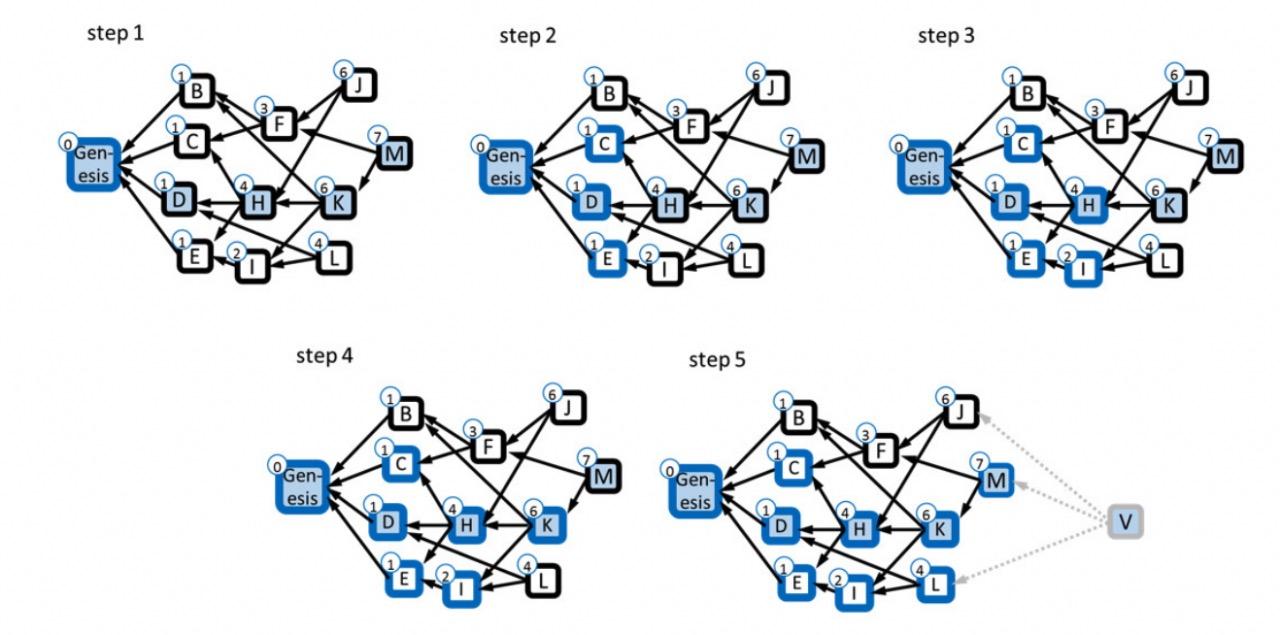
GHOSTDAG diagram, source: "PHANTOM GHOSTDAG: A Scalable Generalization of Nakamoto Consensus"
When k=0, GHOSTDAG is no different from Bitcoin consensus, and the "blue score" is the length of Bitcoin's longest chain. Therefore, GHOSTDAG is essentially a generalization of Bitcoin's longest chain consensus. Since GHOSTDAG sorts network transactions and meets the requirements for Turing completeness, it can theoretically also be used for smart contract development. Thus, the Kaspa team solved the theoretical problem of scaling, and $KAS officially launched in November 2021.
Project Background
Team
Kaspa is primarily led by a development team from Israel, with core developers possessing strong research capabilities, and the founder being well-established in the academic community. Additionally, Kaspa has a robust community, with many volunteers actively participating in project development, network marketing, and user education.
Yonatan Sompolinsky, Founder
Yonatan obtained a Ph.D. in computer science from the Hebrew University of Jerusalem and is currently conducting postdoctoral research at Harvard University, focusing on transaction ordering protocols and MEV. In 2013, Yonatan and his advisor, Professor Zohar, jointly conceived the GHOST protocol, gaining recognition in the cryptocurrency academic community, which was later cited in the Ethereum white paper.
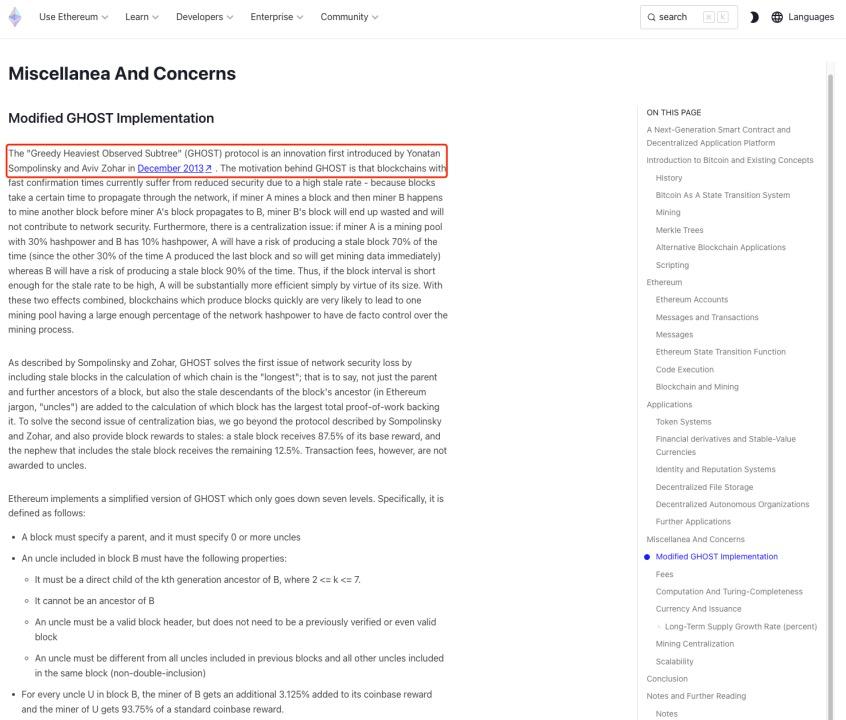
Source: Ethereum White Paper
Yonatan is the founder of the Kaspa project and has made significant contributions to blockchain theoretical research, with several papers recognized by the academic community, accumulating hundreds of citations. It can be said that Yonatan's research on the blockchain trilemma contributed to the birth of the Kaspa project.
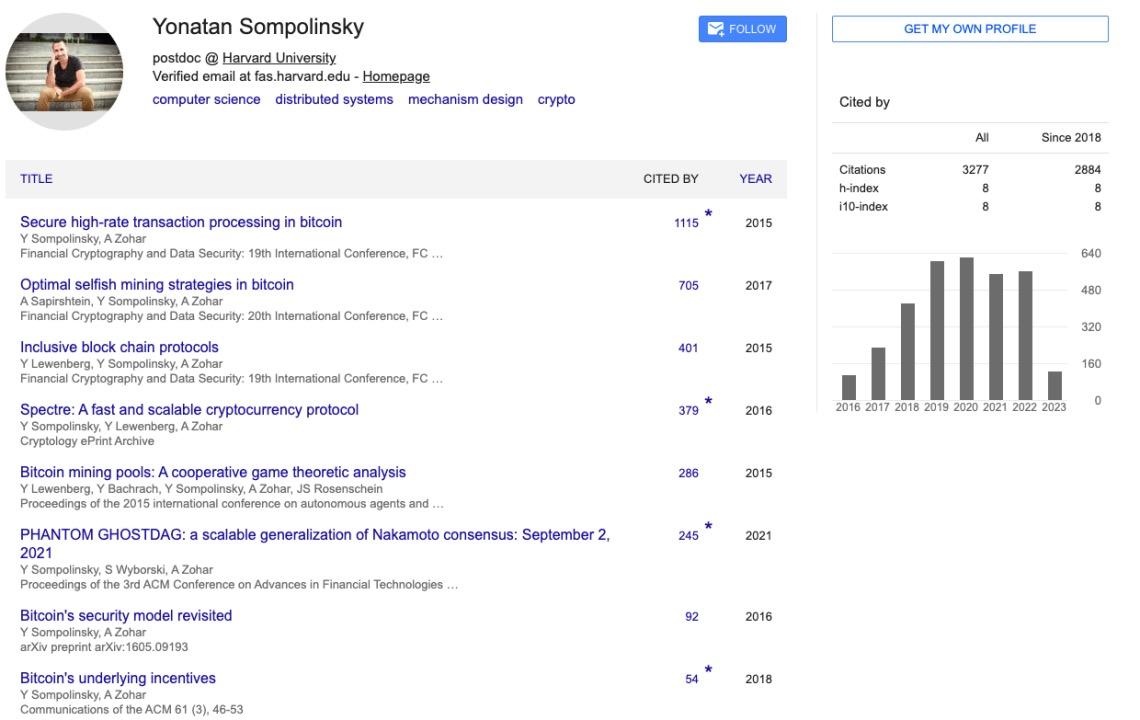
Source: Google Scholar
Michael Sutton, Core Developer
Michael Sutton obtained a master's degree in computer science from the Hebrew University, focusing on parallel algorithms and distributed systems.
Shai Wyborski, Core Developer
Shai Wyborski is pursuing a Ph.D. at the Hebrew University and Ben-Gurion University, primarily researching classical and quantum cryptography.
Mike Zak, Core Developer
Mike Zak is mainly responsible for distributed systems development.
Elichai Turkel, Core Developer
Elichai Turkel focuses on applying cryptographic algorithms and high-performance system development.
Ori Newman, Core Developer
Ori Newman is mainly responsible for distributed systems development.
In addition to the core developers, many other community developers, marketers, and volunteers are actively contributing to the development of the Kaspa ecosystem.

Kaspa community contributors, source: Kaspa official website
Funding
In 2018, Yonatan founded DAG Labs and secured $8 million in funding from Polychain Capital to develop OPOW ASIC miners and conduct DAG research. However, due to the immaturity of OPOW technology and the lack of market interest in POW L1 at the time, DAG Labs decided to dissolve at the end of 2021 and used the remaining funds to rent mining machines for early mining of Kaspa, acquiring approximately 800 million KAS, which was distributed to former employees and Polychain Capital. Strictly speaking, the Kaspa project did not receive any funding; the only way to obtain KAS is through fair mining participation.
Tokenomics
The total supply of $KAS is approximately 28.7 billion, produced through fair mining, with no pre-mining or private investment. The current circulating supply exceeds 17.7 billion, accounting for about 60% of the total supply.
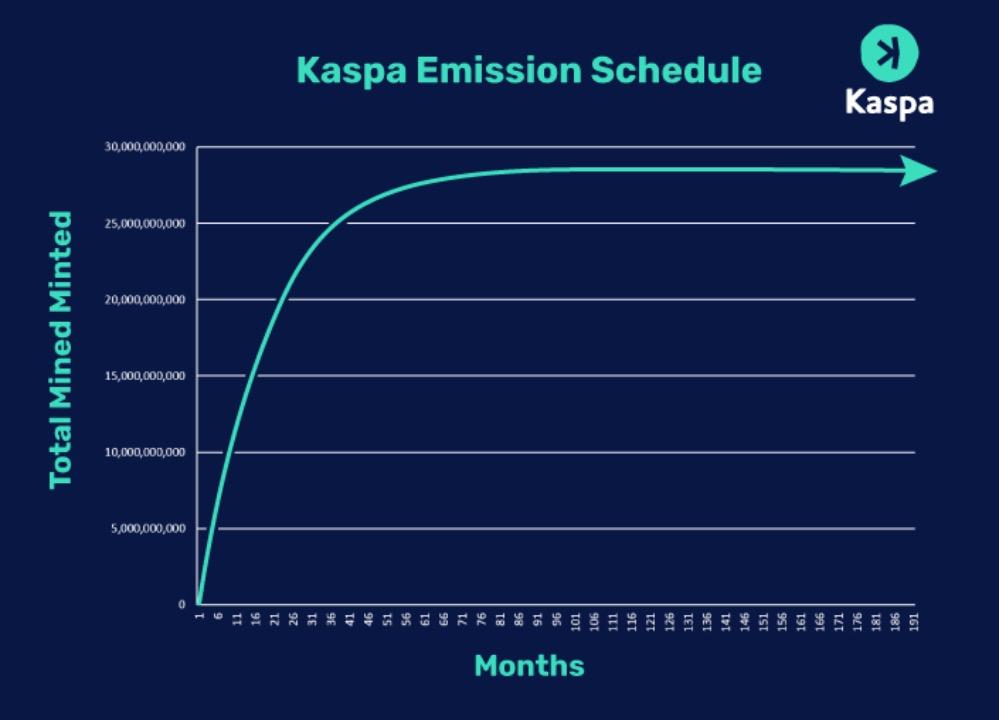
Kaspa output illustration, source: Kaspa official website
Currently, KAS ranks fourth in daily output across the network, following BTC, DOGE, and LTC. With a hash rate of 800 TH/s, it ranks first among GPU-mined coins, while ETC has only 110 TH/s.

POW mining output ranking, source: f2pool
KAS holdings are relatively dispersed, with the top 100 addresses holding about 36.6% of the total supply, and the top 10 addresses holding about 18.9%, with the largest holding address being MEXC, accounting for about 8.4% of the total supply.
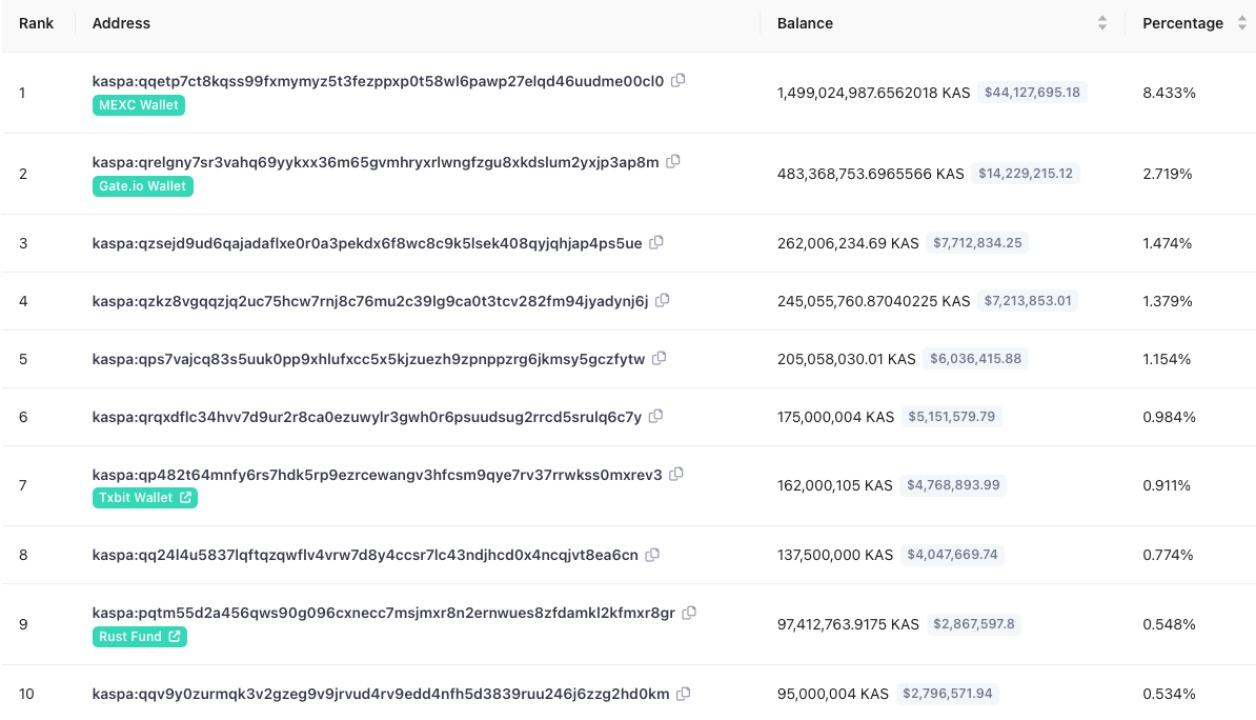
Top ten KAS holding addresses, source: Kaspa block explorer
Development Roadmap
Overall, continuing to enhance network performance and security remains Kaspa's primary goal. The team is currently focusing on completing the following events:
RUST Rewrite
Kaspa was initially written in GoLang, and the team is currently rewriting it in RUST. RUST is a high-performance programming language that can efficiently utilize modern computing hardware and process different blocks in parallel across different CPU threads. This transition will significantly enhance Kaspa's overall performance, with the potential to process more than 10 blocks per second. This plan began in July 2022, led by Michael Sutton, and has entered the testing phase, expected to be completed by mid-year.
Upgrade to DAGKNIGHT Protocol
In October 2022, Yonatan and Michael Sutton published a new paper titled "The DAG KNIGHT Protocol: A Parameterless Generalization of Nakamoto Consensus," proposing an improved version of GHOSTDAG called DAGKNIGHT, further enhancing network performance and security. The team plans to develop DAGKNIGHT after the RUST rewrite is completed.
Mobile Wallet Development
Kaspa already has a web wallet (https://wallet.kaspanet.io/), a desktop wallet (https://kdx.app), and a command-line interface wallet (https://github.com/kaspanet/kaspad), and the team is currently developing a mobile wallet.
Smart Contracts
This is in planning, expected to be developed after the DAGKNIGHT upgrade.
Trading Situation
Currently, KAS is only listed on second and third-tier exchanges, with poor liquidity. Due to its strong technology and community, there is potential for a fee-free listing on Binance in the future.
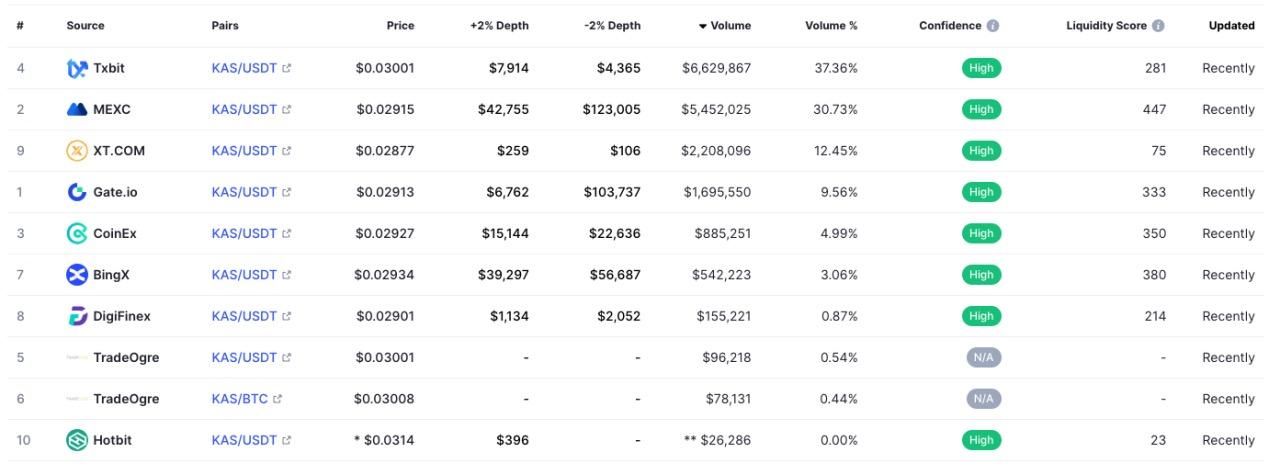
KAS listing situation, source: CoinMarketCap
Valuation Analysis
KAS currently has an FDV of $850 million, with its value primarily derived from providing a better answer to the trilemma. In the short term, the current market cap already reflects high expectations, and further upward momentum may depend on listing on top-tier exchanges. In the long term, future growth will depend on whether Kaspa can become a top public chain, requiring attention to performance improvements, smart contract deployments, and ecosystem development.
We conduct a valuation analysis of KAS under optimistic, neutral, and pessimistic scenarios (the following analysis is based on current market conditions; if the overall market rises or falls, the valuation levels should be adjusted accordingly).
Optimistic: FDV exceeds $10 billion
In an optimistic scenario, Kaspa successfully completes the DAGKNIGHT upgrade within a year, achieving TPS in the thousands, while smart contracts are successfully launched, leading to rapid ecosystem development and widespread use, with TVL reaching $1 billion.
Benchmarking against $MATIC (TVL $1.1 billion, FDV $11 billion) and $AVAX (TVL $870 million, FDV $12.7 billion), it is expected that $KAS will join the ranks of top public chains, with FDV exceeding $10 billion, providing a 10-fold growth potential compared to the current market cap.
Neutral: Market cap reaches $1.5-4 billion
In a neutral scenario, Kaspa successfully upgrades and launches smart contracts within two years, but the market sees public chains with overall better solutions. Additionally, due to a lack of capital support and ecosystem incentives, or performance not meeting expectations and poor user experience, ecosystem development may be slow, with TVL only reaching several hundred million dollars.
Benchmarking against $HBAR (TVL $35 million, FDV $3.3 billion), $ALGO (TVL $120 million, FDV $2.2 billion), $FTM (TVL $450 million, FDV $1.4 billion), and $EOS (TVL $130 million, FDV $1.3 billion), it is expected that $KAS will become one of the second or third-tier public chains, with FDV exceeding $EOS, reaching $1.5-4 billion, providing a growth potential of 1-4 times compared to the current market cap.
Pessimistic: Market cap reaches $500 million-2 billion
In a pessimistic scenario, Kaspa fails to develop smart contracts, ecosystem development stagnates, and its only use is POW mining, leading to a discounted valuation.
Benchmarking against $BCH (FDV $2.6 billion), $BSV (FDV $750 million), and $RVN (FDV $530 million), while Kaspa has certain advantages in security and performance, it lacks user consensus compared to older projects. It is expected that $KAS will have an FDV higher than $RVN but lower than $BCH, roughly reaching $500 million-2 billion, providing a potential growth of 1 time compared to the current market cap.






